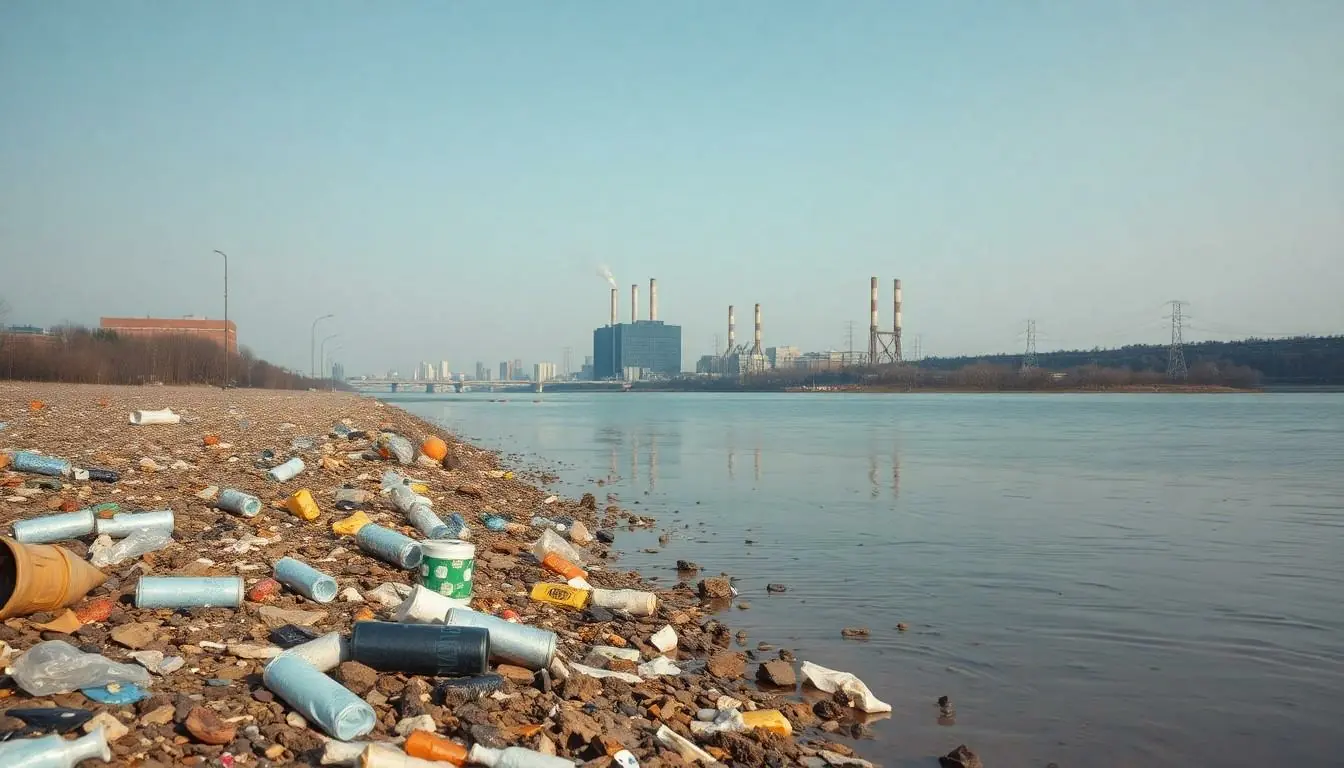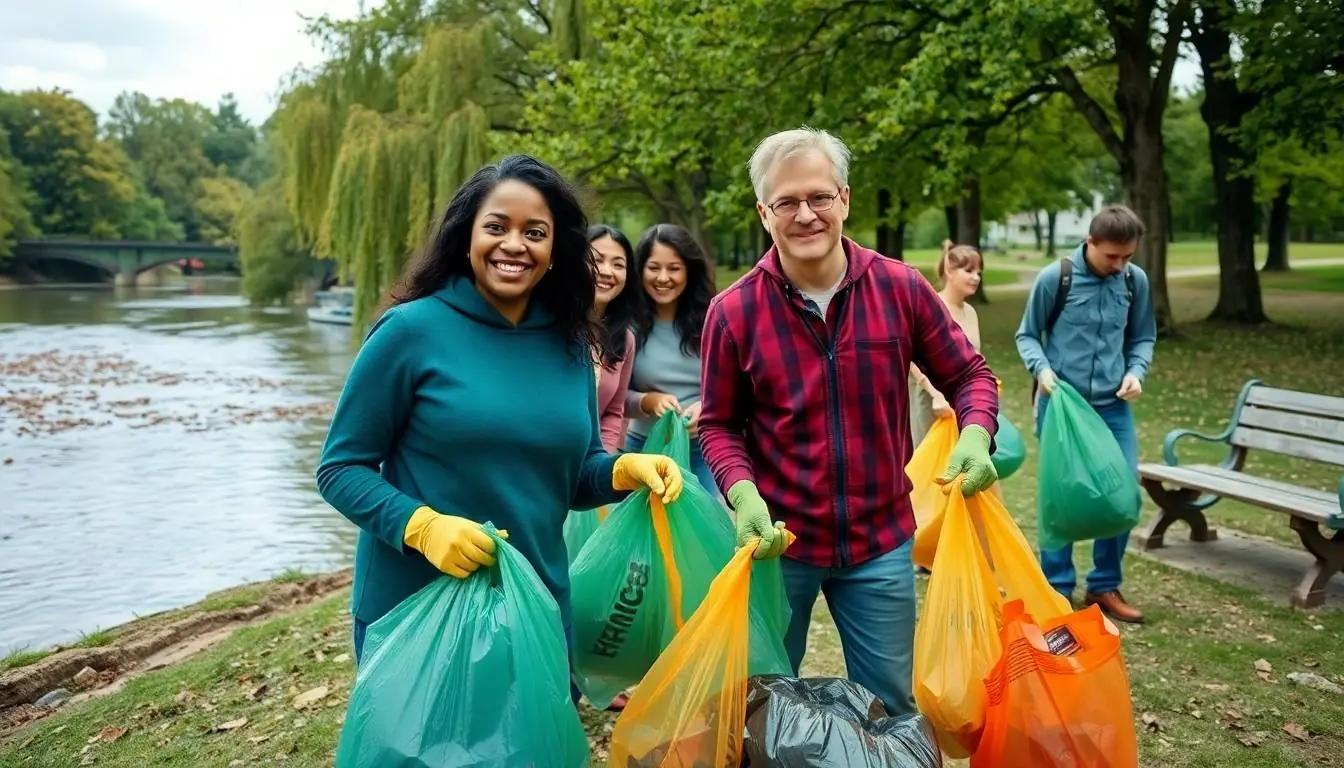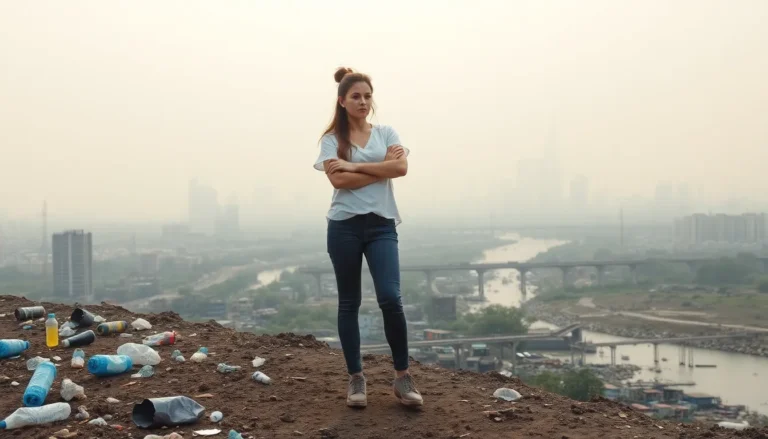Every day, our planet faces a silent crisis as water and land pollution creep into our lives like an uninvited guest who overstays their welcome. It’s time to kick them out! With a little creativity and some elbow grease, anyone can play a role in cleaning up this mess.
Table of Contents
ToggleOverview of Water and Land Pollution
Water pollution occurs when harmful substances contaminate water bodies. Common pollutants include industrial waste, agricultural runoff, and plastic debris. These pollutants endanger aquatic life and disrupt ecosystems. Land pollution results from hazardous waste, pesticides, and excessive plastic use. Soil degradation affects agriculture, threatens food security, and impacts human health.
In recent years, the escalation of both water and land pollution has become increasingly alarming. According to a 2021 report by the United Nations, around 80% of wastewater is released untreated into the environment. This statistic highlights a significant gap in waste management. Furthermore, the World Bank estimates that land degradation could cost the global economy up to $10.6 trillion annually.
Immediate actions contribute to mitigating these pollution types. Implementing waste management systems promotes recycling and proper disposal of hazardous materials. Additionally, eco-friendly agricultural practices help reduce chemical runoff. Regular community clean-up initiatives engage individuals and raise awareness about pollution.
Local governments can enact stricter regulations governing industrial emissions. Organizations dedicated to environmental conservation often lead initiatives that educate communities about pollution consequences. Individuals can make a difference through sustainable practices, like reducing plastic usage and conserving water.
Collective efforts across society can significantly counteract the threats posed by water and land pollution. Engaging in advocacy, supporting clean technologies, and educating others brings positive change. Focusing on sustainable habits creates a healthier environment for future generations while empowering communities to combat pollution effectively.
Understanding the Sources of Pollution

Identifying sources of pollution is crucial for effective mitigation strategies. Water pollution originates from various sectors, significantly impacting aquatic ecosystems.
Water Pollution Sources
Industrial waste contributes substantially to water contamination. Agricultural runoff transports fertilizers and pesticides into water bodies. Plastic debris accumulates in oceans and rivers, harming marine life. Untreated wastewater, over 80% released into environments, exacerbates these issues. Urban runoff also introduces harmful substances from roads and infrastructure. Each source compounds the crisis, jeopardizing aquatic health and biodiversity.
Land Pollution Sources
Land pollution stems from hazardous waste disposal practices. Landfills overflow with non-biodegradable plastics, leading to soil degradation. Chemical spills from industries release toxins into the ground, affecting agriculture. Excessive use of fertilizers and pesticides in farming depletes soil quality. Mining activities disrupt land, introducing contaminants that linger. Communities face significant economic costs from land degradation, with estimates of up to $10.6 trillion annually impacting the global economy. Effective management of these sources is essential to safeguard land health.
Effective Methods to Reduce Water Pollution
Addressing water pollution requires strategic, effective methods. Focusing on wastewater treatment serves as a crucial first step.
Wastewater Treatment Solutions
Incorporating advanced treatment technologies can significantly enhance water quality. Municipalities often utilize processes like biological treatment, which effectively removes organic matter from wastewater. Implementing filtration systems also helps capture contaminants before water is released back into the environment. Many facilities now aim for zero liquid discharge, ensuring no wastewater returns untreated. Public awareness campaigns often emphasize the importance of proper disposal methods, reducing domestic contributions to pollution. Engaging local communities in monitoring efforts further strengthens these initiatives.
Sustainable Agricultural Practices
Applying sustainable practices in agriculture leads to noticeable reductions in water pollution. Crop rotation promotes soil health and reduces dependence on chemical fertilizers. Integrated pest management minimizes pesticide use and protects nearby water bodies. Implementing buffer zones along waterways acts as a safeguard against runoff. Utilizing cover crops helps prevent erosion and filter pollutants before they enter aquatic systems. Many farmers also adopt precision agriculture, providing exact nutrient and water needs tailored to each crop, minimizing excess input. Educational programs often target farmers, enhancing awareness about these methods’ benefits for both productivity and the environment.
Effective Methods to Reduce Land Pollution
Reducing land pollution requires practical strategies that communities can implement effectively.
Recycling and Waste Management
Implementing recycling programs plays a crucial role in minimizing landfill waste. Communities can establish local recycling facilities that accept various materials, such as plastics, glass, and metals. Educating residents on sorting recyclables ensures effective processing. For instance, composting organic waste significantly reduces the volume of trash sent to landfills. Local governments can support these initiatives by providing accessible bins and organizing collection events. Encouraging businesses to adopt waste reduction practices leads to less waste generation.
Eco-Friendly Farming Techniques
Adopting eco-friendly farming techniques contributes significantly to reducing land pollution. Practices such as crop rotation improve soil health and reduce dependency on chemical fertilizers. Utilizing natural pest control methods prevents harmful chemicals from contaminating the soil. Integrating cover crops protects soil from erosion and enhances organic matter content. Community-supported agriculture programs foster local produce consumption, lessening the need for chemical inputs. Finally, applying sustainable irrigation practices conserves water and decreases soil degradation. Implementing these strategies supports healthier ecosystems and promotes agricultural sustainability.
Role of Legislation in Pollution Reduction
Legislation plays a crucial role in mitigating water and land pollution. Governments can establish and enforce regulations that limit harmful emissions from industries, reducing the amount of industrial waste entering waterways. Stricter laws on waste disposal help prevent hazardous materials from contaminating soil and water sources.
Environmental protection agencies monitor compliance with these regulations. In many countries, the Clean Water Act and the Resource Conservation and Recovery Act serve as foundational laws promoting clean water and proper waste management. Compliance reduces the likelihood of disasters that can arise from poorly managed hazardous wastes.
Recent studies show that the enforcement of pollution control laws leads to measurable reductions in contamination levels. Successful case studies demonstrate that regions with stringent environmental regulations often experience significant improvements in water quality and soil health. For instance, areas involved in rigorous monitoring initiatives report fewer instances of waterborne diseases.
Community involvement complements legislative efforts. Local governments can initiate educational campaigns to inform residents about compliance requirements and pollution impacts. Public awareness can foster greater community engagement, leading to volunteer efforts to clean up polluted areas.
International agreements also contribute to pollution reduction. Treaties such as the Paris Agreement establish common goals for preserving ecosystems and lowering greenhouse gas emissions. Participating nations commit to specific targets that support global environmental health.
Adaptation of innovative technologies further enhances legislative measures. Advanced monitoring systems enable real-time tracking of pollution levels, providing data that inform policy adjustments. Development of green technologies incentivizes industries to adopt more sustainable practices.
Collective action becomes essential in achieving pollution reduction goals. When legislation, community efforts, and technological innovations align, significant progress can occur. The combined effort creates a cleaner, healthier environment for all.
Community and Individual Initiatives
Community and individual initiatives play a crucial role in reducing water and land pollution. Organizing local clean-up events offers one effective way for residents to actively engage in environmental preservation. Participants can target specific areas in parks, riverbanks, or beaches, removing debris and raising awareness about pollution.
Implementing recycling programs strengthens community commitment to sustainability. Many organizations provide resources and training, helping residents learn how to recycle properly. Encouraging schools to integrate environmental education into their curriculums fosters a sense of responsibility among younger generations.
Individual contributions matter significantly. People can adopt eco-friendly practices at home, such as using less plastic, conserving water, and choosing sustainable products. Planting trees and creating community gardens enhances local ecosystems while promoting biodiversity.
Establishing local environmental groups encourages collaborative efforts. These groups often partner with local government and businesses, focusing on projects like rainwater harvesting or promoting organic farming practices. Engaging citizens in discussions about pollution helps address specific community concerns and promotes collective solutions.
Utilizing social media platforms amplifies awareness. Sharing stories about local pollution issues can mobilize community support and drive participation in initiatives. Creating informative campaigns on the impacts of pollution contributes to a well-informed public, encouraging behavioral changes.
Advococacy for stricter regulations can be a powerful tool. Residents can lobby local governments to enforce existing environmental laws or propose new legislation. Building alliances with environmental organizations enhances these efforts and can provide guidance on best practices for effective advocacy.
Varying community and individual initiatives significantly contribute to minimizing pollution levels. Active participation, education, and advocacy are vital components in creating cleaner environments and a healthier future.
Reducing water and land pollution requires a multifaceted approach that combines community engagement, innovative technologies, and strong legislation. Individuals can make a difference through simple actions like recycling and reducing plastic use. Local governments play a pivotal role by enforcing regulations and supporting sustainable practices.
Collective efforts amplify the impact of these initiatives, fostering a sense of responsibility among residents. By prioritizing environmental education and advocating for stricter policies, communities can work together to combat pollution effectively. The path to a cleaner environment lies in collaboration and commitment, ensuring a healthier planet for future generations.





